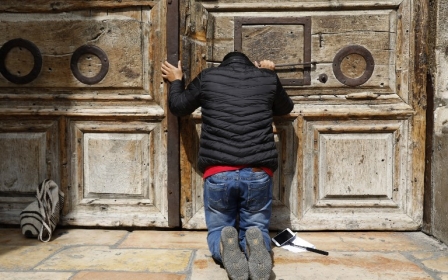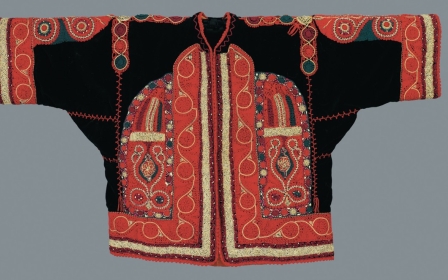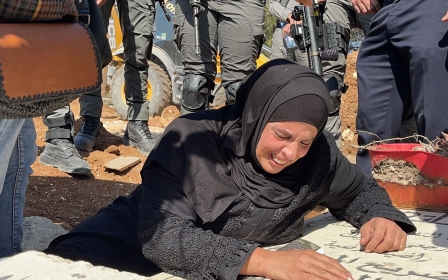Standing on history: The Jerusalem fabric shop built on a Crusader church
The Old City of Jerusalem is something of an open air museum, packed with ancient structures and historic mosques, churches and synagogues. But there are also archaeological treasures buried beneath its existing streets and buildings that got there with the passage of time, helped along by natural disasters, such as earthquakes. One shop in the Aftimos market has a particularly special piece of history hidden underneath it. (All images: Aseel Jundi)
Bilal Abu Khalaf is a Jerusalemite who makes his living importing and selling textiles from as far away as Morocco and India. His shop has a fascinating history of its own, but it also stands on top of the remains of a 12th century Crusader church. Excavated in the early 2000s by the Israel Antiquities Authority, Abu Khalaf had the option of either covering up the remains or leaving them visible with a glass floor. He chose the latter.
Ehab al-Jallad, a researcher specialising in the history of Jerusalem, says that the Christian quarter where Abu Khalaf's shop is located was once base to the Knights Hospitaller, a leading Christian order involved in the Crusades.
They built a hospital in the name of the patron saint of their order, St John, and a complex made up of churches, including the St Mary La Grande church, to which the remains under the shop belong.
After Saladin wrestled control of Jerusalem from the Crusaders in 1187, the area continued to be used as a hospital. Later, under the Ottoman Empire, it was a tannery, before finally being turned into a market.
Al-Jallad explains that earthquakes reduced prior structures to rubble and that new buildings would be built on top of them, explaining how the church remains ended up under Abu Khalaf's store. In the picture above, stone foundations from the church are visible.
Bilal Abu Khalaf was born in 1961 and was groomed from a young age to take over the family business. Eventually, he fell in love with the fabric trade. It's a tradition that has been in the family for generations.
In the 1930s, his grandfather was a peddler selling fabrics to villagers around the city of al-Khalil (Hebron) in the now-occupied West Bank. In 1936, he decided to move to Jerusalem, where he bought a shop in the Christian Quarter. The patriarch passed on his trade to his son, who in turn passed it on to Bilal.
“My father was the top destination for the Jordanian soldiers in Jerusalem prior to the occupation of East Jerusalem in the Six Day War of 1967. The soldiers would come for the tailoring of their formal suits. One suit would cost three Jordanian dinars. They paid in four monthly instalments," Abu Khalaf recalls.
Bilal’s father passed away in 1984, but not before expanding the business with multiple outlets in the Jerusalem area. Abu Khalaf believes customers are drawn to his business by the quality of fabrics on sale, which are distinct for the materials they are made out of. They are a world away from the synthetic materials that customers are used to.
Tourists are drawn to the store by its historic relics, colourful shop floor and Bilal's distinct dress, made up of a long belted tunic and fez hat. The majority of non-local visitors to the store come from Egypt, Saudi Arabia and Kuwait. There are also religious tourists who visit the Old City from Europe.
Abu Khalaf tells Middle East Eye that the best fabrics are from Syria and that he has been importing from the country for decades because the materials produced there are exclusively hand woven.
A fabric known as "damask silk" is woven from a blend of silk and cotton thread and is used in traditional attire. One variant of the Syrian product is a fabric that is made from a blend of silk and gold thread - 10 metres of this takes 40 days to make.
Other notable materials include "religious fabrics", which are made in distinct colours for various Christian denominations and for Jewish rabbis.
Abu Khalaf says: “Christian clergymen wear four colours for four different reasons: red for Christmas, green for fasting, lilac for Easter, and white for baptism and purification rituals at the Jordan River."
Among his most notable customers was the late Pope John Paul II, who bought fabrics including five metres of silk and thread made of nine carat gold, which were taken back to the Vatican for tailoring.
Besides the Syrian fabric, other popular options include Moroccan material, which is primarily used for table covers and pillow cases. There is also an Indian fabric, which is normally used for producing sari-type dresses, as well as cashmere shawls and carpets.
The fabrics are just as notable for their designs, as well as their material make up. One called “Saladin” depicts the sultan's warriors entering Jerusalem on horseback after winning the Battle of Hattin.
This article is available in French on Middle East Eye French edition.
Middle East Eye delivers independent and unrivalled coverage and analysis of the Middle East, North Africa and beyond. To learn more about republishing this content and the associated fees, please fill out this form. More about MEE can be found here.




